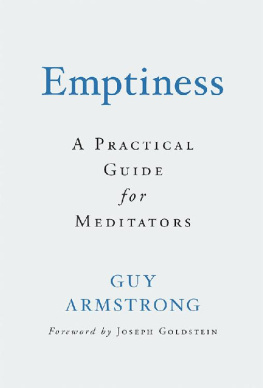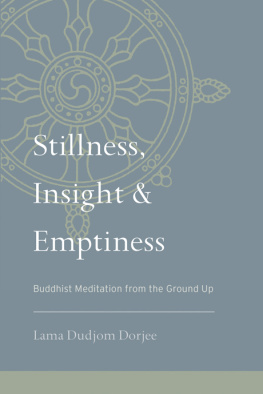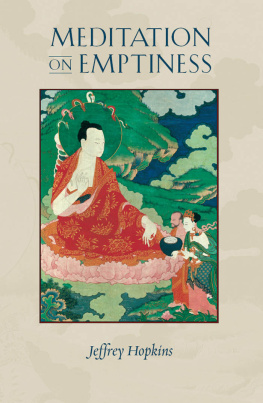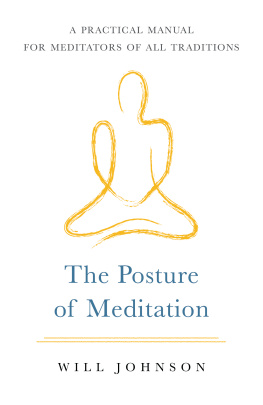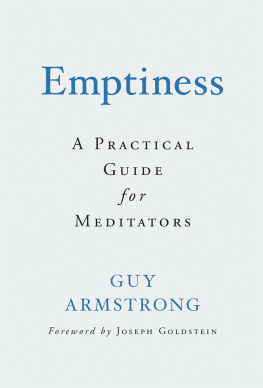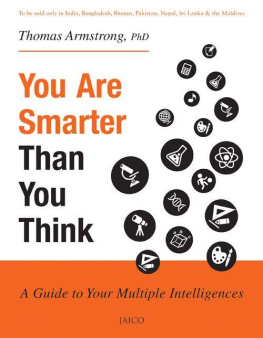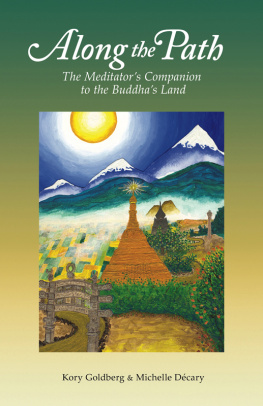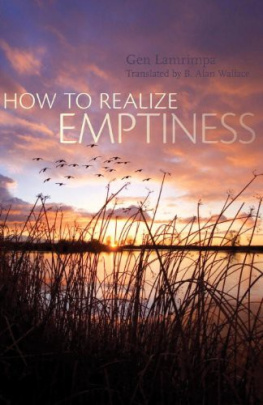Guy Armstrong - Emptiness: A Practical Guide for Meditators
Here you can read online Guy Armstrong - Emptiness: A Practical Guide for Meditators full text of the book (entire story) in english for free. Download pdf and epub, get meaning, cover and reviews about this ebook. year: 2017, publisher: Wisdom Publications, genre: Religion. Description of the work, (preface) as well as reviews are available. Best literature library LitArk.com created for fans of good reading and offers a wide selection of genres:
Romance novel
Science fiction
Adventure
Detective
Science
History
Home and family
Prose
Art
Politics
Computer
Non-fiction
Religion
Business
Children
Humor
Choose a favorite category and find really read worthwhile books. Enjoy immersion in the world of imagination, feel the emotions of the characters or learn something new for yourself, make an fascinating discovery.
- Book:Emptiness: A Practical Guide for Meditators
- Author:
- Publisher:Wisdom Publications
- Genre:
- Year:2017
- Rating:5 / 5
- Favourites:Add to favourites
- Your mark:
- 100
- 1
- 2
- 3
- 4
- 5
Emptiness: A Practical Guide for Meditators: summary, description and annotation
We offer to read an annotation, description, summary or preface (depends on what the author of the book "Emptiness: A Practical Guide for Meditators" wrote himself). If you haven't found the necessary information about the book — write in the comments, we will try to find it.
Emptiness: A Practical Guide for Meditators — read online for free the complete book (whole text) full work
Below is the text of the book, divided by pages. System saving the place of the last page read, allows you to conveniently read the book "Emptiness: A Practical Guide for Meditators" online for free, without having to search again every time where you left off. Put a bookmark, and you can go to the page where you finished reading at any time.
Font size:
Interval:
Bookmark:

For anyone seeking to understand emptiness, this is a clear and fine guidebook, with precise and practical ways to explore and deepen your practice.
Jack Kornfield, author of
A Path with Heart
Emptiness is a brilliant and practical introduction to the practice and attainment of liberation. Encapsulating Guy Armstrongs decades of dedicated Buddhist practice and study, Emptiness presents profound Buddhist teachings and describes ways practitioners can experience them for themselves. This is an important foundation for anyone interested in the meditation practices of Buddhism.
Gil Fronsdal, author of
The Buddha before Buddhism
To the teachers who kindly pointed me toward emptiness: Joseph Goldstein, Tsoknyi Rinpoche, Christopher Titmuss, and of course Gotama Buddha
You should train yourselves thus: When those discourses spoken by the Tathgata that are deep, deep in meaning, supramundane, dealing with emptiness, are being recited, we will be eager to listen to them, will lend an ear to them, will apply our minds to understand them; and we will think those teachings should be studied and mastered. Thus should you train yourselves.
The Buddha, Samyutta Nikya 20:7
CONTENTS
FOREWORD
IN THIS REMARKABLE BOOK , Guy Armstrong guides the reader through the foundational realizations necessary to explore the profound truth of emptiness and the increasingly subtle understandings of its deeper meanings.
For thousands of years, different Buddhist schools have highlighted aspects of the path to freedom, each reflecting the liberating insights of its own particular tradition and from time to time, there have been great masters who have seen what is held in common by many of these schools and woven together paths of practice that integrate elements from each of them. Guys eminently practical and deeply investigative work follows in this nonsectarian tradition, weaving together teachings from the Pali Canon, the writings of Chinese and Japanese Zen masters, and the great Tibetan lineage-holders. He does this so skillfully that in the very reading of the book we are led to a more comprehensive understanding of the path and the various skillful means needed for its fruition.
What makes this book so user-friendly is its nondogmatic presentation of views. While referencing different points of controversy among the various Buddhist schools, Guys approach remains pragmatic: How do these teachings help to liberate the mind? With this wonderfully clear book he invites us to consider and practice different approaches, all of which lead to our own deepening and freeing realization of the nature of awareness and its intrinsic emptiness and to the manifestation of compassion in our lives.
Joseph Goldstein
PREFACE
The world is full of obvious things which nobody by chance ever observes.
Sherlock Holmes
Truth lives all around me but its just beyond my grasp.
Country Joe McDonald
IVE ALWAYS LIKED A GOOD MYSTERY. From Sherlock Holmes to John le Carr, Ive been fascinated by the idea that theres more going on than meets the eye. In college I majored in physics, because I loved the way science reveals things that are hidden from ordinary view. In grad school I studied computers to find out how machines could do such amazing things. Psychology was always an interest, because the mind, too, is a vast, unknown land. In all these disciplines, I discovered that close observation, pointed questions, and sustained reflection were the keys to unlock the gates.
When I stumbled onto Buddhism, I was delighted to find a whole new set of mysteries to explore. From the age of twenty-eight, I began to dedicate my life to learning what I could from teachers and meditation, including a year in Asia as a Buddhist monk. Many of the teachings I encountered made good common sense, and I was grateful for their emphasis on wise choices in speech and action. Meditation was a marvel that brought me a measure of calm, but my conceptual mind was most intrigued by things I couldnt quite understand, like not-self, enlightenment, nirvana, and emptiness. It seemed that comprehending these subjects must be necessary to realize the path of transformation and freedom, but however much I thought about them in the beginning, I couldnt penetrate them. Still, the glimmerings of these mysteries inspired me, and I was determined to explore them further. After some years, I began to teach what I had learned, primarily through leading silent retreats in the Insight meditation tradition.
The word mysteries has long had religious connotations. In both ancient and modern cultures, there have always been priests and priestesses, nuns, monks, and shamans seeking to learn from the mysteries and thereby shift their relationship to themselves and others, to life and to death. This book is intended for those today who are drawn to these subtle realms. Emptiness is the theme, as it is a core teaching closely connected to the other mysteries. For the truth of emptiness to reveal itself fully in our hearts and minds will require inquiry and reflection, as well as a deep intuition born from meditation, which is is simply another name we give to close observation. In truth the keys that unlock the mysteries of science also unlock the mysteries of spirit.
For two and a half millennia, Buddhist practitioners have explored emptiness and found the highest levels of happiness and freedom. This book is offered in the hope that it might encourage a few more people to take a few more steps along this sacred path.
INTRODUCTION
When emptiness is possible, everything is possible. Were emptiness impossible, nothing would be possible.
Ngrjuna
EMPTINESS IS AN ODD TERM for the central philosophy of a world religion. It certainly lacks the emotional appeal of Hinduisms bliss and devotion, for instance, or Christianitys love and charity. It is not a word designed to attract newcomers. More than just austere, it sounds a little off-putting. Who would gravitate to a way of life based on what sounds like nothingness?
In fact, the insights pointed to by emptiness are deeply liberating and bring great happiness. They transform how we understand ourselves and life in profound ways. Many of those who have practiced the Buddhas teaching on emptiness regard it as the greatest gift he offered the world. Nonetheless, it is not an easy subject to approach.
When I first became interested in the concept of emptiness in Buddhism, I read a hefty volume with a respectable pedigree that defined emptiness as the lack of inherent self-existence. I didnt doubt the author, but that definition didnt mean much to me at the time. Other works couch emptiness in terms of dependent origination, which is also intellectually challenging. The fact that so many books have been written about emptiness points to both the richness and the complexity of the subject.
Mingyur Rinpoche is a bright young Tibetan lama who, not too long ago, returned from a four-year personal retreat wandering the Himalayas. On his first visit to California in 1998, I had a chance to visit with him and show him around Marin County. As we drove I tried to strike up a conversation. How do you find the West? I asked. Square and clean, was his reply. Do you think Tibetans are happier than Westerners? Yes. End of conversation.
We reached our destination at the top of Mount Tamalpais and were walking along the trail around the summit, an asphalt track about six feet wide, when I thought Id try again. What is the difference between the Dzogchen view and the Madhyamaka view? I asked, referring to two schools in Tibet that are considered to have different understandings of the nature of reality.
Next pageFont size:
Interval:
Bookmark:
Similar books «Emptiness: A Practical Guide for Meditators»
Look at similar books to Emptiness: A Practical Guide for Meditators. We have selected literature similar in name and meaning in the hope of providing readers with more options to find new, interesting, not yet read works.
Discussion, reviews of the book Emptiness: A Practical Guide for Meditators and just readers' own opinions. Leave your comments, write what you think about the work, its meaning or the main characters. Specify what exactly you liked and what you didn't like, and why you think so.

